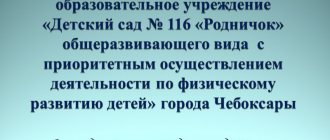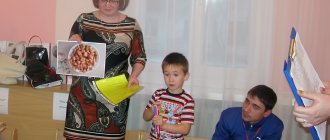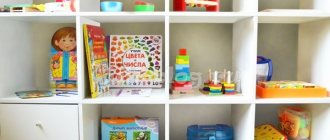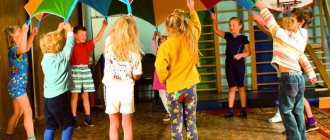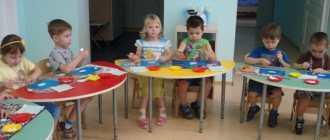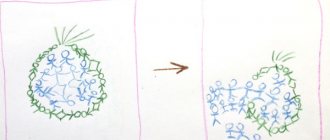Program “Visiting a Fairy Tale”
12
BUZ VO “Pavlovsky sanatorium for children with parents named after I.G. Menzhulin"
PROGRAM
"Visiting a fairy tale"
Program of activities for children of middle and senior preschool age
Educational psychologist
L.S. Slavgorodskaya
Pavlovsk 2015
Explanatory note
The fairy tale is loved not only by children, but also by adults who listened to fairy tales as children. The pedagogical importance of the fairy tale genre can hardly be overestimated: it introduces children to the world around them, moral standards, the laws of life and teaches them to live according to these laws. Thanks to artistic images and a special fairy-tale language, children develop a sense of beauty.
The fairy tale lifts the curtain into a world of secrets and miracles, into a hidden but clearly tangible world. A fairy tale narrative is timeless: you will never understand where and when its action takes place, which means the fairy tale is eternal. She raises the most important questions: about good and evil, about the purpose of man and the path of life.
Folk tales educate a child in the traditions of the people, convey to him a vision of life based on the spiritual and moral views of the people. The role of Russian folk tales in the education and formation of the spiritual and moral world of the Russian child is invaluable. These tales are structured according to a certain rhythm, the same one that organized the life of Russian people with seasonal agricultural work, seasonal changes in life and the annual church circle. The Russian people carefully preserved and passed on from generation to generation not only the plot, but also the speech patterns of fairy tales. The language of fairy tales, rich in aphorisms, repetitions and epithets, is very poetic; it refines and elevates the soul of those listening. No wonder such connoisseurs of the Russian word as A.S. Pushkin, M.Yu. Lermontov, V.A. Zhukovsky, believed in the transformative power of fairy tales. And Russian thinkers - I.A. Ilyin and E.N. Trubetskoy – saw in the fairy tale a reflection of the soul of the Russian people.
“It seems certain that the fairy tale contains a rich mystical revelation; her rise from the mundane to the miraculous, her search for “another kingdom” represents the great value of spiritual life and an undoubted step in the ladder that leads the people’s consciousness from paganism to Christianity.”
– wrote E.N. Trubetskoy.
In our age of spiritual impoverishment, the fairy tale, like other values of traditional culture, is losing its high purpose. This is largely facilitated by modern book publishers and creators of children's cartoons, which distort the original meaning of the fairy tale, turning the fairy-tale action from morally instructive into purely entertaining. Russian folk tales present children with a poetic and multifaceted image of their heroes, while leaving plenty of room for imagination. Cartoons, while offering their own interpretation, impose certain images that deprive children of a deep and creative perception of the fairy tale.
It is very sad that in modern young families the role of grandmothers in raising their grandchildren is distorted and lost. Grandmothers-storytellers are irreplaceable in childhood; they are the connecting link of generations and traditions. It is they who, having encountered many difficulties and trials in life, understand more deeply the meaning of fairy tales and, telling them to their grandchildren, pass on to them their own piece of life experience. Through fairy tales, the older generation teaches childhood to build life according to the laws of goodness and beauty. That’s why our program strives to bring “grandmother’s tales” back into children’s lives.
Program Goals
1. Promoting the harmonization of psycho-speech and general development of preschool children undergoing sanatorium treatment
2. Implementation of correction of violations of the emotional-volitional and behavioral sphere of children through a variety of activities related to the content of Russian fairy tales.
3. Promoting the social adaptation of children, introducing them into cultural tradition through folk and original fairy tales, using small genres of folklore, introducing children to musical and pictorial works based on fairy tales.
Program objectives
- Expand children's understanding of the world around them by introducing them to literary and musical culture.
- Promote the development of children's speech, enrichment of vocabulary, development of figurative structure and coherent speech skills.
- To develop social skills in children: sociability, friendly behavior, the desire to share impressions of what they heard, saw, felt, the need to please loved ones with the results of their work.
- Develop skills of voluntary behavior: attentiveness, patience, diligence.
- To help children assimilate moral categories: good - evil, obedience - disobedience, agreement - enmity, hard work - laziness, selflessness - greed, simplicity - cunning and the rules of a good, conscientious life.
- To promote the development of the motivational sphere of preschoolers, the formation of the desire to imitate the positive heroes of fairy tales.
- To develop children's ability to distinguish good from bad in a fairy tale and in life, the ability to make moral choices.
- To promote the development of skills of friendly, attentive, caring behavior.
- Cultivate obedience based on love and respect for parents and loved ones, patience, mercy, the ability to give in, help each other and gratefully accept help.
- Create conditions for the active inclusion of children in speech, music, art, and play activities related to the figurative structure and plot of a fairy tale.
- Develop aesthetic taste, the ability to see, appreciate and cherish beauty.
- Cultivate diligence, the habit of doing business, working diligently and accurately, finishing what you start, and respecting the results of others’ and your own work.
- Promote the development of basic productivity skills.
Objectives of music education in cycle classes
1. Development of understanding of musical language from folklore to musical classics.
2. Formation of the ability to listen to music by gradually complicating the musical material.
3. Formation of understanding and participation in the interpretation of musical images.
4. Development of musical memory.
5. Teaching children to express themselves independently, the ability to convey impressions of what they heard.
6. Teaching children the motor transmission of musical images through small musical performances.
7. Formation of moral qualities to establish positive interpersonal relationships.
8. Promoting the improvement of mental processes: attention, imagination, memory and thinking.
Features of program construction
The program classes involve the use
– folk and original, Russian and foreign fairy tales,
– small genres of folklore: riddles, proverbs, sayings,
- epic,
– educational stories from children's reading circles.
At the beginning of the race, simple and short Russian folk tales are taken, in the second half of the race - long original fairy tales, deeper in content and more complex in perception.
To promote the figurative perception of fairy tales, illustrative material is used: book illustrations, reproductions of paintings by V.M. Vasnetsov (they help children to more vividly experience the images of heroes and events of a fairy tale), imaginative and didactic toys, photographs, postcards, works of decorative and applied art.
The musical part plays an important role in the program. Music has a tremendous emotional impact on a child’s psyche. The interest in music therapy among doctors and psychologists, who have learned the therapeutic value of music through practical experience, is constantly growing.
The role of classical music is especially important, which is still far from being fully used to improve the spiritual structure of the child.
Classical music in itself already has a harmonizing effect on the psyche of children. And in combination with a fairy tale, this influence is mutually enhanced: music enriches a work of art, spiritualizes it, gives special depth to its images, and a literary work helps a child understand musical language, facilitates his acquaintance with the new world of musical images, with new forms and genres of musical classics.
The program allows you to go from Russian folklore, close and accessible to children's understanding, through children's classics in musical literature, to the heights of chamber, instrumental and symphonic creativity of the largest Russian composers.
Each lesson involves the use of various types of artistic activity in the practical part: drawing, appliqué, modeling. Artistic and productive activities develop fine motor skills in children, contribute to the formation of aesthetic taste, and expand their understanding of the world around them.
Class structure
Each lesson includes a number of stages:
1. Listening to a fairy tale with the inclusion of musical fragments.
2. Examination of illustrations and discussion of the content of the tale, clarifying the main idea. Games, dramatization, musical and motor activities.
3. Organization of artistic and productive activities: drawing, modeling, appliqué, designing on the theme of a fairy tale.
Educational and thematic planning
(11 lessons, daily, every arrival)
| No. | Fairy tale title | Subject |
| 1. | “Turnip” | “Where they are friends, they live, they don’t grieve” |
| 2. | “Kolobok” | “Flattery has no teeth, but will eat you with bones” |
| 3. | “Teremok” | "In crowded but not mad" |
| 4. | “Cat and Rooster” | "Friend is known in trouble" |
| 5 | “The Ant and the Dove” | “Die yourself, but help your friend” |
| 6. | "Masha and the Bear" | “A fool will turn sour, but a wise man will provide for everything” |
| 7 | "Swan geese" | “When trouble comes, you can’t buy intelligence” |
| 8 | “Porridge from an axe” | “Ingenuity is the second happiness” |
| 9. | Test lesson | Repetition of covered literary and musical material in a playful way: riddles, musical quizzes, dramatizations. |
| 10. | “Two Frosts” | “With labor and frost is not terrible”, “Labor warms” |
| 11. | Final lesson |
Lesson No. 1 “Turnip”
Subject:
common cause, the significance of small help
.
Program content:
1. Develop the ability to: a) respond to a request;
b) accept even the smallest help.
2. Teach children to do things together, amicably, harmoniously.
3. Clarify children’s ideas about vegetables, in particular about turnips (color, shape), find out what is prepared from turnips.
Musical part
Task
: First acquaintance with Russian folklore.
Musical material:
Recordings of Russian folk songs “Bai, kachi”, “The cat went into the woods”, “Cats, kittens”.
Practical part
: relief modeling “Turnip”
Material for the lesson
: text of the fairy tale “Turnip”, illustrations for the fairy tale, audio cassettes, plasticine, boards for modeling, stacks.
Lesson No. 2 “Kolobok”
Topic:
Cunning is caution, arrogance is prudence, boasting is laziness.
Program content:
1. Through a fairy tale, let children understand why bragging does not lead to good, why it is dangerous to be arrogant, they need to learn obedience.
2. Teach children to listen carefully and answer questions.
3. Cause a negative attitude towards boasting, flattery and other manifestations of pride.
4. Teach children to be careful in their actions.
Musical part
Task
: First acquaintance with musical images.
Musical material:
1. Introduction. The image of the fairy tale “Russian folk song” in the recording of P.I. Tchaikovsky
2,4,6,8,10. Theme Kolobok Maikapar “In the kindergarten”
3. Hare theme. Galynin “Bunny”
5. Wolf theme Bartok “Song”
7. Bear theme Galynin “Bear”
9. Theme of the fox Grechaninov “Primrose”
Practical part:
three-dimensional modeling of kolobok and forest animals.
Material for the lesson:
text of the fairy tale “Kolobok” with illustrations, colored plasticine, board for modeling, stack, notes.
Lesson No. 3 “Teremok”
Topic
: the ability to live together
.
Program content:
1. Teach children to analyze the actions of fairy tale characters and their consequences.
2. Foster hospitality, goodwill, friendliness.
3. Discuss with the children the proverb “In trouble, but not in harm’s way” and understand its meaning.
4. Teach children to look at illustrations, noticing interesting details.
5. Clarify children’s ideas about the types of houses and the features of different buildings.
Musical part
Task
: First acquaintance with conveying action through music.
Musical material
1. Introduction. The image of the fairy tale “Russian folk song” in the recording of P.I. Tchaikovsky
2-7. The animals live happily in the “Cossack” house, arr. A. Dargomyzhsky
8. The bear sits down on P.I.’s tower. Tchaikovsky “Children’s Album”, “A Man Playing a Harmonica”.
Practical part:
application “Teremok
”.
Material for the lesson:
text of the fairy tale “Teremok” with illustrations, colored paper, scissors, glue, notes.
Lesson No. 4 “Cat and Rooster”
Topic
: friendship, mutual assistance, obedience
.
“ A friend is a friend in need,” “Life is hard without a friend.”
Program content:
1. Teach children to be friends and help each other.
2. Using the events of a fairy tale as an example, help children understand that disobedience is the cause of trouble.
3. Teach children to be attentive and careful.
4. Clarify and expand children’s understanding of domestic animals.
Musical part
Task
: We continue to get acquainted with Russian folk songwriting.
Musical
material:
Recordings of Russian folk songs by V. Astrov “You little kitty cat”, “The cat went to the mountain”, “Cockerel.”.
Practical part:
modeling “Cockerel”.
Material for the lesson:
text of the fairy tale “The Cat and the Rooster” with illustrations, colored plasticine, boards for modeling, stacks, audio cassettes.
Lesson No. 5 “The Ant and the Dove”
Subject:
Mercy, gratitude, mutual assistance.
“Perish yourself, and help your friend,” “Debt is worth paying.”
Program content:
1. Develop a sense of gratitude in children.
2. Foster mercy and the desire to help a friend in trouble.
3. When retelling, teach children to consistently build the plot of the story they listened to.
Musical part
Task
: Development of figurative perception.
Musical material:
1. Image of a stream T. Nazarov-Medtner “Trickles”
2. Image of the dove by M. Andreev “Titmouse Birds”
3. The image of a hunter R. Schumann “Album for youth” “Hunting song.”
Practical part
: paper craft “Dove”.
Material for the lesson
: text “The Ant and the Dove”, colored paper, markers, glue, scissors, notes.
Lesson No. 6 “Masha and the Bear”
Subject:
Hard work, disobedience, intelligence, courage, resourcefulness, caring for family.
Program content:
1. Develop attentiveness and care for others, love for family.
2.Teaches children to be smart and resourceful in trouble.
3. Teach children to verbally describe the moral image of the main characters
fairy tales.
Musical part
Task
: Participation in the creation of images based on Russian folklore.
Musical material:
“Russian folk song” arr. N. Rimsky-Korsakov “A little girl walked on the borochka.”
Practical part:
modeling “Box with pies”
Material for the lesson:
text of the fairy tale “Masha and the Bear”, illustrations for the fairy tale, colored plasticine, stack, notes.
Lesson No. 7 “Geese-swans”
Subject:
Obedience - disobedience, love - selfishness, responsibility.
Program content:
1. Teach children to keep promises, correcting mistakes in behavior, overcoming difficulties.
2. Cultivate in children attentiveness and caring towards their relatives.
3. Develop a sense of responsibility for your actions.
4. Teach children to be obedient and friendly.
Musical part
Task
: Introduction to musical dramaturgy.
Musical material:
1. Introduction - an image of the fairy tale “Russian Folk Song” recorded by P.I. Tchaikovsky
2.12. Fun games, dancing P.I. Tchaikovsky “Children’s Album”, “Kamarinskaya”
3,5,7,9,11. The theme of searching and rescuing brother “Meadow Duckling”
“Russian song” arr. I. Berkovich
4,6,8,10. Baba Yaga and the Geese-Swans Prokofiev “Children’s Music”, “Fairy Tale”
Practical part:
applique made of paper and natural material “Geese fly away”.
Material for the lesson
: text of the fairy tale “Geese-Swans”, illustrations for the fairy tale, sheet music, dried leaves, colored paper, glue, paper figures of geese-swans.
Lesson No. 8 “Porridge from an ax”
Topic:
inhospitality - friendliness, incompetence - resourcefulness, simplicity - cunning
.
“
Ingenuity is the second happiness.”
Program content:
1. Clarify children’s understanding of traditional manifestations of goodwill and hospitality; that it is easier and better to act kindly (you won’t end up in a stupid position, like the old woman in a fairy tale);
2. Cultivate kindness, responsiveness, hospitality, the ability to find a way out of a difficult situation;
3. Teach children to understand the allegorical meaning of a fairy tale.
Musical part
Task: Conveying image and character through musical means.
Musical material:
1,2,3,4,5. The image of a soldier R. Schumann “Album for Youth”
6. Russian savvy P.I. Tchaikovsky “Children’s Album”, “Russian Song”
Practical part: drawing “How a hospitable hostess will set the table.”
Materials for the lesson: text of the fairy tale “Porridge from an Axe”, brushes, album sheets, paints, sheet music.
Lesson No. 10 “Two Frosts”
Topic: Hard work - laziness, simplicity - ingenuity.
“With labor and frost is not terrible”, “Labor warms”.
Program content:
1. Teach children to independently and consistently retell the content of a fairy tale.
2. Strengthen children’s understanding of the seasons.
3. To cultivate in children a love and interest in work.
Musical part
Objective: Involving children in an active creative process with the help of Russian folklore by staging fairy-tale material.
Practical part: preparing for the New Year. Collective production of New Year's garland with winter pictures.
Materials for the lesson: text of the fairy tale “Two Frosts”, illustrations, audio cassettes and sheet music, colored paper, scissors, glue.
LITERATURE FOR THE PROGRAM
1. Andersen G.H. Wild swans and other tales. – Sofia: 1964
2. Anikin V.P. Russian folk tales. – M.: 1984
3. Heroic tales. – M.: 1995
4. Galerkina O. Artist V.M. Vasnetsov. – L.: 1957
5. Dal V.I. Proverbs of the Russian people
- J. Rodari. The grammar of fantasy. – M.: 1978
- Ilyin I.A. The spiritual world of a fairy tale. – M.: 1993
8. Mints S.I., Pomerantseva E.V. Russian folkloristics. – M.: 1971
9. On Buyan Island. – M.: 1999
10. Russian folk tales. – M.: 1982
11. Perrault S. Fairy tales. – M.: 1993
12. Russian folk tales. – M.: 1958
13. Trubetskoy E.N. “Another Kingdom” and its seekers in a Russian folk tale. –M.: 2000
14. Tumina L.E. “Write a fairy tale” group. – M.: 1995
15. Ushinsky K.D. Native word. – Novosibirsk: 1997
16. Fesyukova L.B. Education with a fairy tale. – M.: 2000
17. Shamaeva S.V. Apology for a fairy tale. – Voronezh: 1994
18. Shanina N.F. V. Vasnetsov. –L.: 1979

